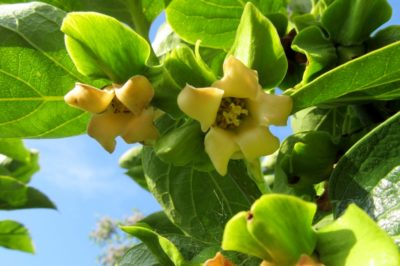Male Persimmon Flowers
On malepersimmon trees, the flowers open in inflorescences, or clusters, of two to four. Like rows of tiny pink-tinged bells, they dangle from short, branching stalks. Each one measures about 1/3 inch long and contains up to 16 pollen-producing stamens.
Stamens
The stamens’ job is to produce and release pollen containing the male flowers’ genetic code. Each one has a slender filament topped with a pollen-producing anther.
Female Persimmon Flowers
On female persimmon trees, flowers open as single, pale-yellow blooms. They share the male flowers’ shape and short stalks, but are about twice their size. Each female flower has a pistil with four styles.
Pistils and Styles
A female flower’s pistil contains the ovaries, where its seeds develop. The four styles inside each pistil are stalks with sticky, pollen-trapping receptacles called stigmas.
Pollen trapped on the stigmas works its way down the pistil to the ovaries, where it fertilizes the ovules that produce the seeds. To protect and nourish the developing seeds, the ovaries around them swell into the berries we know as persimmon fruits.
Expert gardener’s tip: Male persimmon flowers can only pollinate female flowers from a tree of the same species. American persimmon trees (Diospyros virginiana, USDA zones 4 through 10) flowers, in other words, can’t pollinate Oriental persimmon trees (Diospyros kaki, USDA zone 7 through 11).
Self-Pollinating Persimmons
Some persimmon cultivars produce ‘perfect’ flowers with large ovaries at their bases and eight or more stamens inside centers. Basically, they’re bi-sexual and in the right conditions — capable of self pollination and producing seedless fruit.
They include the American persimmons:
- ‘Prok’
- ‘Yates’
- ‘Meader’
- ‘Early Golden’
- ‘Prairie Dawn’
and the Oriental persimmons:
- ‘Fuyu’
- ‘Hachiya’
- ‘Maekawa Jiro’
- ‘Ichi Ki Kei Jiro‘
Expert gardener’s tip: Even though these cultivars can self-pollinate, they aren’t dependable. To boost their chances of setting fruit, many commercial growers plant them with a reliable male pollinator.
Pollinators
Bees are persimmon flowers’ primary pollinators, with wind helping out when bees are scarce. Expect the bees to collect nectar and pollen from dawn until dusk during the trees’ two-week spring bloom period.
